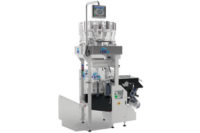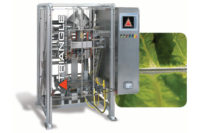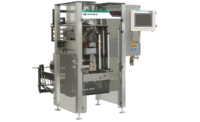When Matrix Packaging Machinery (matrixpm.com), powered by Pro Mach, began designing the company’s next generation vertical form-fill-seal (VFFS) platform, the design team focused on creating the most versatile machine possible. This involved understanding likely bag sizes and types, production speeds, film formulations and thicknesses, machine size footprint, motion control complexities, and all the other minor but essential elements of the target applications. Next, team members looked beyond the basics and asked, “How can we make this new, technically more complex platform simpler to operate and support?” During the subsequent development of the first two machines based on the Matrix next generation platform, the high speed continuous motion Morpheus and the intermittent motion Apollo, Matrix identified fundamental considerations when evaluating VFFS that go beyond the obvious. Based on the work of the Matrix next generation team, here are six not-necessarily-obvious tips when exploring a VFFS purchase.
Tip One: Determine the difficulty level of changeover adjustments.
As the U.S. nears full employment, and as skilled workers retire at a faster rate than they are being replaced, employers face multiple labor related challenges, including the tension between the shortage of technically savvy workers and the increasing complexity of production system.
Consider the complexity of operating VFFS machines on lines where there are frequent changeovers. VFFS vacuum pull belts and sealing jaws must be precisely coordinated in terms of adjustments for each width of bag and type of film. Every time width or film type changes, settings across a range of vacuum-pull-belt axes must be precisely readjusted and the heat setting of the jaws recalibrated for changes in film thicknesses. Not an easy task even for experienced workers.
When evaluating VFFS, ask the manufacturer how many mechanical items need to be adjusted and what systems the manufacturer created for ease of adjustment, precision and repeatability. Ideally, product changeover is a minor task for both operator and maintenance technician.
Tip Two: Look for an intuitive HMI.
Spend time when purchasing VFFS on an examination of the human machine interface (HMI). Consider whether typical operators, both native English speakers and English-as a-second-language personnel, can easily navigate through the HMI with moderate training. Determine how many clicks are required to arrive at the right screen, with fewer being better. Successful HMIs will resemble smart phones: The HMI will be populated with understandable and memorable icons and a minimum of words.
Maintenance personnel must be able to go deeper into the system than operators, yet intuitive smart-phone-like interfaces are also a must for these skilled workers. Maintenance technicians are fewer in number today and are asked to work on more machines of higher complexity. The HMI should give them access to tools such as technical manuals, images, drawings and diagnostics that they require to accomplish tasks quickly and effectively.
Tip Three: Determine the remote diagnostic capabilities of the machine.
Ask the VFFS OEM about the availability of remote diagnostics, including vision systems that can show the OEM technicians key sections of the machine. VFFS customers should discuss with the OEM the practicality of incorporating remote support systems on the new machine or retrofitting later. Encourage the OEM to detail the company’s approach to the security of remote connectivity. Having an effective, secure remote diagnostic system augments the internal maintenance team with OEM VFFS experts.
Tip Four: Complex machines require simple design elements.
Even as controls and mechanical systems become more complex, the machines themselves must incorporate simplified design elements. For example, determine how easy or hard it is to replace a film roll and thread the machine. How easy is it to clean? How easy is it to service right down to the accessibility of essential nuts, bolts and screws during preventive maintenance? Ask to be shown how simple design elements supporting complex machines contribute to lower cost of ownership, including material utilization.
Tip Five: How flexible is the VFFS really?
Shorter product life cycles and a proliferation of product variations create a competitive advantage for VFFSs that can manufacture bags with an extensive range of widths and film thicknesses. This range is not always available because it is difficult to engineer one sealing jaw that can run both narrow and wide widths at comparably high speeds. A wide jaw is heavier than a narrow one and simply can’t move as fast on smaller bags. Making machines flexible as well as affordable is one of the most difficult engineering challenges facing OEMs today. Yet, finding the right balance of flexibility allows the packaging operation to adapt to new circumstances, improves line performance and ultimately lowers cost.
Tip Six: Become serious about overall equipment effectiveness.
At a time when every percentage point of machine utilization improves the bottom line, it is vital to understand the root causes of lost productivity. Overall equipment effectiveness (OEE) metrics provide measurements of each system on the line in terms of availability, performance and quality. For example, an operator reports the VFFS is running slow. Does the problem reside with the VFFS or on a system upstream or downstream of the machine? Personnel within the operation may not have the technical expertise and/or the time to delve into complex performance interactions. OEE automated collection of data and analysis fills the evaluation void. And like having OEM experts available via remote diagnostics, a powerful OEE data collection and analysis tool bolsters organizational effectiveness. Ask the VFFS OEM what its OEE systems involve and how it will access all systems on the line. Customization is essential for usefulness, so determine how easily reports can be produced that reflect the environment where the new VFFS will be situated.
Utilizing one or more of these not-so-obvious evaluation tips will help the prospective VFFS buyer make a more informed and productive purchase.







